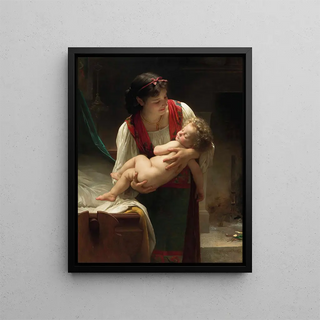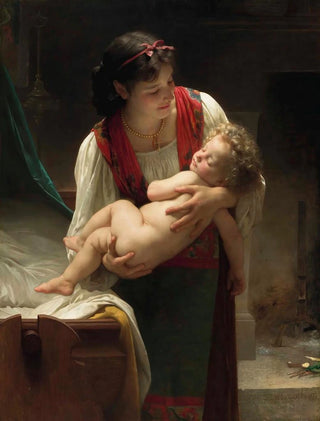Art print | Lullaby the bedtime - William Bouguereau


View from behind

Frame (optional)
In the world of art, some works manage to capture the very essence of humanity, and "Lullaby at Sunset" by William Bouguereau is a perfect example. This painting, imbued with softness and tenderness, depicts an intimate scene where motherhood and serenity meet. The viewer is immediately transported into a universe where time seems to stand still, where the beauty of everyday gestures is highlighted. The portrayal of a mother gently rocking her child, enveloped in an atmosphere of calm and warmth, reminds us of the depth of family bonds and the magic of childhood. This piece, both simple and complex, embodies a moment of life that resonates deeply within each of us.
Style and uniqueness of the work
Bouguereau's style is distinguished by striking realism, exceptional technical mastery, and meticulous attention to detail. In "Lullaby at Sunset," every element is carefully crafted, from the expressions of the characters to the textures of the fabrics. Light plays a crucial role in this composition, creating a soft and soothing ambiance. Pastel colors, harmonious and delicate, add to the poetry of the scene, while Bouguereau's fine strokes reveal rare sensitivity. This artwork does not merely depict a mother and her child; it evokes a universal emotion, that of unconditional love. The artist manages to capture the fleeting moment of a sunset, a symbol of the end of a day and the promise of a new beginning, while celebrating the beauty of family life.
The artist and his influence
William Bouguereau, an emblematic figure of the 19th century, established himself as one of the masters of academic realism. His career, marked by numerous works celebrating the human figure and nature, profoundly influenced his contemporaries and subsequent generations. Bouguereau developed a unique style, blending classical tradition with modern sensitivity, which captivated a wide audience. His approach to painting, based on meticulous observation and faithful representation of reality, helped elevate the status of figurative art. Although criticized by some for

Matte finish

View from behind

Frame (optional)
In the world of art, some works manage to capture the very essence of humanity, and "Lullaby at Sunset" by William Bouguereau is a perfect example. This painting, imbued with softness and tenderness, depicts an intimate scene where motherhood and serenity meet. The viewer is immediately transported into a universe where time seems to stand still, where the beauty of everyday gestures is highlighted. The portrayal of a mother gently rocking her child, enveloped in an atmosphere of calm and warmth, reminds us of the depth of family bonds and the magic of childhood. This piece, both simple and complex, embodies a moment of life that resonates deeply within each of us.
Style and uniqueness of the work
Bouguereau's style is distinguished by striking realism, exceptional technical mastery, and meticulous attention to detail. In "Lullaby at Sunset," every element is carefully crafted, from the expressions of the characters to the textures of the fabrics. Light plays a crucial role in this composition, creating a soft and soothing ambiance. Pastel colors, harmonious and delicate, add to the poetry of the scene, while Bouguereau's fine strokes reveal rare sensitivity. This artwork does not merely depict a mother and her child; it evokes a universal emotion, that of unconditional love. The artist manages to capture the fleeting moment of a sunset, a symbol of the end of a day and the promise of a new beginning, while celebrating the beauty of family life.
The artist and his influence
William Bouguereau, an emblematic figure of the 19th century, established himself as one of the masters of academic realism. His career, marked by numerous works celebrating the human figure and nature, profoundly influenced his contemporaries and subsequent generations. Bouguereau developed a unique style, blending classical tradition with modern sensitivity, which captivated a wide audience. His approach to painting, based on meticulous observation and faithful representation of reality, helped elevate the status of figurative art. Although criticized by some for






